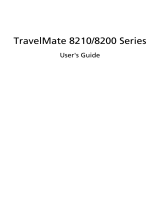
Table of contents - 3
TABLE OF CONTENTS
Safety and comfort 5
First things first 15
Your guides ...................................................... 15
Basic care and tips for using your
computer .......................................................... 15
Turning your computer on and off............. 15
Taking care of your computer ................... 16
Taking care of your AC adapter................ 17
Cleaning and servicing.............................. 17
Your Acer computer tour 19
Computer ......................................................... 19
Front view ................................................ 20
Back view ................................................. 21
Top view ................................................... 22
Bottom view ............................................. 22
Left/right views ........................................ 23
LED Indicators .......................................... 25
Environment ..................................................... 25
Keyboard cover ................................................ 26
Keyboard front view ................................. 26
Hotkeys ..................................................... 28
Inserting the computer into the
keyboard cover ......................................... 29
Removing the computer from the
keyboard cover ......................................... 31
Using the keyboard ................................... 32
Pairing with the P3 .................................... 33
Charging the keyboard.............................. 34
Troubleshooting ........................................ 34
Universal Serial Bus (USB) 35
HDMI Micro 36
Using the virtual keyboard 37
Wireless networks 39
Connecting to the Internet ............................... 39
Wireless networks ........................................... 39
Acer clear.fi 41
Navigating media and photos .......................... 41
Shared files .............................................. 41
Which devices are compatible? ............... 42
Playing to another device......................... 42
Screen orientation
and G-sensor 43
Power management 44
Acer Green Instant On..................................... 44
Saving power................................................... 45
Battery pack 48
Battery pack characteristics............................. 48
Optimizing battery life............................... 50
Checking the battery level........................ 50
Battery-low warning.................................. 50
Securing your computer 52
Using passwords ............................................. 52
Entering passwords.................................. 53
Frequently asked questions 54
Requesting service .......................................... 55
Tips and hints for using Windows 8................. 57




















